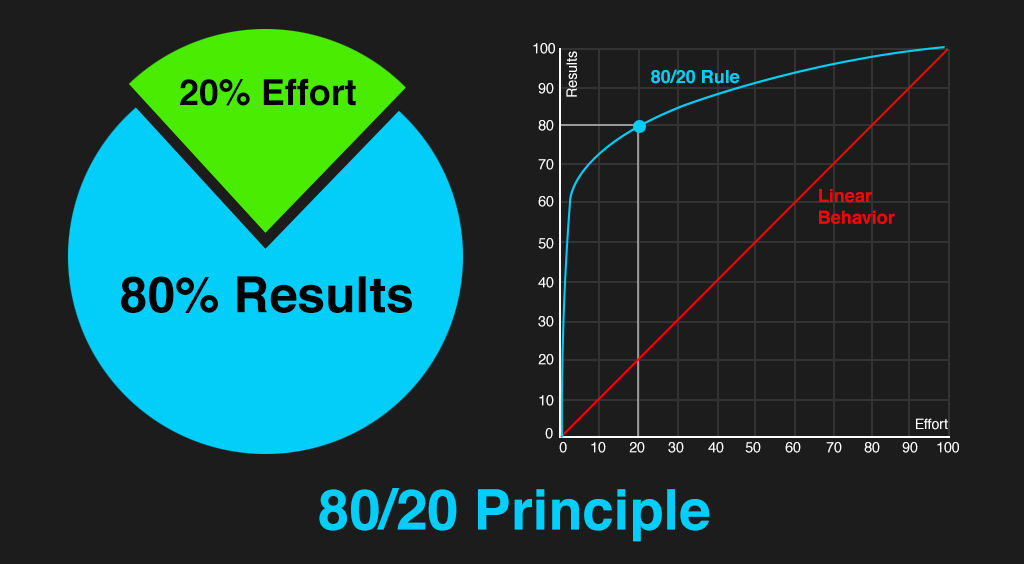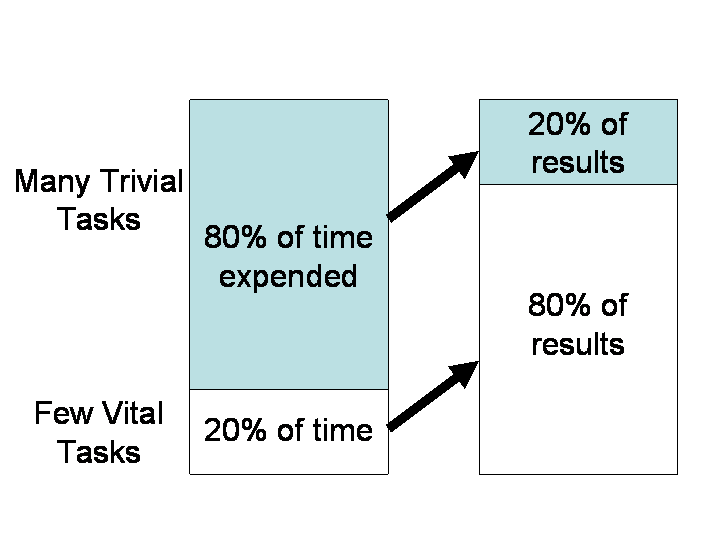There are two things that are always in short supply on any project; time and money. The Pareto Principle can, in the long-term, help you save both. It can also help you make intelligent decisions based on your user research.
Our story begins with a Management Consultant Joseph M Juran back in the 1940s. He noticed that there is a general rule in business and in life – that 80% of the effects of a process come from just 20% of the inputs. He named this principle the “Pareto Principle” after the Italian Economist Vilfredo Pareto (1848-1923).
Pareto had published “Cours d’economie politique” back in 1896. He had observed that 80% of Italy’s land was owned by 20% of the population. He’d also noticed that 20% of the peapods in his garden contained 80% of the peas.
Why Does This Matter?
The Pareto Principle is useful because it allows us to focus our efforts on the areas that bring the most rewards. It’s used in almost every business discipline. For example, sales people will note that 20% of their accounts bring 80% of their sales. Marketers will find that 20% of their campaigns generate 80% of their leads and so on…
It’s important to note that 80%/20% is not exact. For example, you may find that these numbers change when you examine your own situation. So in the UK at the moment you’ll find that the top 20% of the country owns just over 50% of the wealth of the nation.
What is almost always true is that a small proportion of the efforts (inputs) will generate a larger than expected level of results (outputs).
The Pareto Principle and UX

It doesn’t matter how complex your website or application is, you will find that when you dig down into user analytics – the Pareto Principle will come into play. A small fraction of the functionality (or pages) will receive the majority of user time; this doesn’t mean that the rest of the functionality or content has no value but it does mean that some functionality and content is more important to the majority of your users than some of the rest.
This is important because it enables you to focus your research on the things that matter most and ensuring that you protect these things when you come to revising the user experience. If you degrade or reduce the impact of what most users want from you; you’re going to lose users along the way. Conversely if you can improve the user experience of these core attributes of your product – you’re more likely to win over new users and encourage user loyalty.
Again, if you start to talk to users about what they’d like to see when it comes to enhancing the user experience – you’re going to see the Pareto Principle at play as often as not. The vast majority of users are likely to feel strongly about a narrow range of improvements; again this doesn’t mean that other improvements are not valuable but it does show which improvements you should prioritize.
This can be really useful on projects with tight timescales or small budgets. Focusing on the areas that will bring the largest benefits to the most people is a very sensible way to manage a project in these circumstances.
A note of caution should be applied here – just because a lot of users ask for something, it doesn’t mean that they will value the eventual implementation. You can’t use the Pareto Principle to eliminate ongoing user research; it’s for focusing your attention on what should matter rather than guaranteeing it in this case.
You will find the Pareto Principle in play in other areas of your research too. For example, the customer support/helpdesk function will find that the majority of their calls/e-mails/etc. concern a few simple problems. Again concentrating on fixing these problems will have the greatest impact for the largest portion of your user base.
How to Use the Pareto Principle
Whenever, you have quantitative data – you may be able to apply the Pareto Principle. It’s simply a question of grouping that data and seeing how large a section of your audience is affected by any given unit of data.

Author/Copyright holder: Prezi. Copyright terms and licence: All rights reserved. Img source
It’s important to consider the sample size when you use the Pareto Principle. You need to ensure that your research or analysis covers a sufficient sample size to be statistically relevant. If you base, for example, your customer care analysis on 5 helpdesk calls – you probably don’t have enough data to apply the Pareto Principle sensibly to it.
There’s also another issue to be careful of – one set of figures may be more important than another. Many companies will have a few clients that represent the lion’s share of their revenue. If you are conducting analysis that will lead to a Pareto Principle driven decision making process… you probably want to give these customers more weight than the customers who don’t make you as much money.
So, for example, you have 500 helpdesk calls and 400 of them relate to a problem with Feature A, 80 relate to Feature B and only 20 relate to Feature C – it’s normally a no-brainer at this point to focus your efforts on fixing Feature A but if all the calls relating to B or C come from high revenue clients and the calls relating to Feature A do not… you may still want to focus your efforts on fixing B or C first.
Data should always be used in the largest context available and Pareto Principle decision making is no different.
The Take Away
The Pareto Principle or 80-20 Rule can be very effective in helping you make decisions in your user experience work. From research and analytics to higher level stuff like project management, wherever there is data that can be quantified there’s the possibility that you can use this rule to focus your efforts on the areas of your work that bring the most results.
However, you always need to be mindful of sample sizes and of other forms of data which may override the Pareto Principle in practice.
Resources
Wiki explains the maths and examines multiple applications of the Pareto Principle here: https://en.wikipedia.org/wiki/Pareto_principle
Forbes magazine shows that the Pareto Principle can be used to drive business growth: http://www.forbes.com/sites/davelavinsky/2014/01/20/pareto-principle-how-to-use-it-to-dramatically-grow-your-business/
Pinnacle Management talks about the Pareto Principle here and offers some precautions on how to avoid becoming overly-reliant on it here: http://www.pinnicle.com/Articles/Pareto_Principle/pareto_principle.html
Measuring U looks at some real UX data and how the Pareto Principle might apply to it here: http://www.measuringu.com/blog/pareto-ux.php
Hero Image: Author/Copyright holder: Ana Zdravic. Copyright terms and licence: All rights reserved.Img











